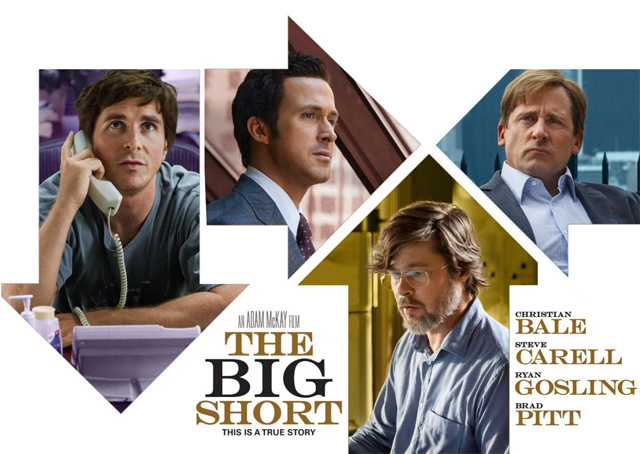
The business lingo may skew your judgment during the beginning of “The Big Short,†but it becomes a well-deserved watch as the plot later picks up. “The Big Short,†directed by Adam Mckay, is a film derived from the original book called, “The Big Short: Inside the Doomsday Machine.†This film adaptation successfully manages to maintain it’s serious plot while being whimsical simultaneously making it one of the best-written films in 2015.
The housing market crash of 2008 saw a substantial drop in the values of homes and caused many homes to foreclose. One of the reasons why the housing market crashed was because the number of loans that was given out for homes around 2003 to 2007 increased drastically. The housing market peaked in 2006, and many of the loans that were given out became defaulted.
The Big Short takes place around 2006 to 2008 and viewers can obviously look back at history and predict the outcome of the climax. What’s interesting about this fact, is that the audience is expected to want to know how the story plays out.
Just like the slow buildup when going up a roller coaster and going down fast, the film starts off extremely slow and the climax feels rushed in. Everything happens all at once. Cutting from character to charterer, there is no focal point that identifies what exactly is going own. But beyond that, the film’s score helps set the mood in every scene. The upbeat and dramatic music, makes the score correspond to the intended scene.
The first scene of this movie identifies the overall tone of the film. The narrator, Ryan Gosling, helps steer the direction of the story that’s being told. The other supporting characters help establish the storyline. While doing this, these characters would briefly stop mid-conversation to define terms that only professional bankers, stock brokers, or business owners are more likely to understand.
This movie is filled complicated business phrases, so you may find yourself scratching your head and having a hard time keeping up with the character’s fast paced acting. It sometimes feels like playing catch-up when trying to understand what’s going on. The film never fully explains the premise or meaning behind particular scenes.
At times, the characters would occasionally break the fourth wall in order to interact with the audience. This is where the film shines the most. The creative directing left the most memorable impression. The different scenes, rhetoric, camera angles and character development was nearly perfect.
Every character in the film is unique and helps build the intended atmosphere of the film. Christian Bale, the leading actor, is an out of an ordinary stock broker and the first one to discover the housing market crash. He’s not like a typical white collar worker. He wears casual clothing and unashamedly walks around his office barefoot. Out of every character, he’s the favorite. Almost every person who was put in a position where their job becomes more important than their own health can relate to his tenacious personality. He enjoys his work so much that he isn’t afraid to make arrogant risks.
Ryan Gosling’s character is a bit snarky and tries to reap the benefits of the crash. He’s far from level headed and helps incorporate the well needed comedic value into the film. But , his humor is his character’s downfall. Yes, he’s entertaining, but at particular moments it gets annoying. He acts just like the annoying little brother that tries to be funny at the wrong time just to get attention. Some of his eccentric acting is unnecessary and would’ve been much better if it didn’t make it into the final cut of the film.
“The Big Short†is also important for individuals who want to become more knowledgeable about the corruption that still occurs in America’s economy. It reveals the truth about how people in the upper class would manipulate those who are unaware of their finances, just to make a profit. This film isn’t for the simple thinkers. It’s for those who want to experience a cleverly written and directed film. It’s for people who are okay with dealing with an ambiguous plot and comfortable with slowly having to put the pieces of the puzzle together themselves.

Leave a Reply